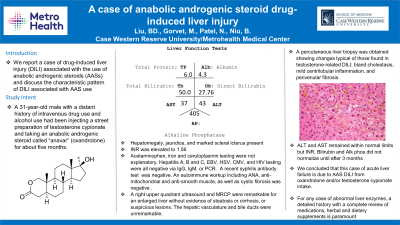Sunday Poster Session
Category: Liver
P1040 - A Case of Anabolic Androgenic Steroid Drug-Induced Liver Injury
Sunday, October 22, 2023
3:30 PM - 7:00 PM PT
Location: Exhibit Hall

Has Audio
- BL
Benjamin D. Liu, MD
MetroHealth
Cleveland, Ohio
Presenting Author(s)
Benjamin D. Liu, MD1, Marissa Gorvet, BA, MS2, Neil D. Patel, MD1, Bolin Niu, MD3
1MetroHealth, Cleveland, OH; 2Ohio University Heritage College of Osteopathic Medicine, Athens, OH; 3MetroHealth Medical Center, Cleveland, OH
Introduction: We report a case of drug-induced liver injury (DILI) associated with the use of anabolic androgenic steroids (AASs) and discuss the characteristic pattern of DILI associated with AAS use.
Case Description/Methods: A 31-year-old male with a distant history of intravenous drug use and alcohol use had been injecting a street preparation of testosterone cypionate and taking an anabolic androgenic steroid called “anavar” (oxandrolone) for about five months. Examination revealed hepatomegaly, jaundice, and marked scleral icterus. The patient had a direct bilirubin of 27.76 mg/dL, total bilirubin of 50.0 mg/dL, GGT of 18 U/L, alk phos of 405 U/L and an ALT and AST of 43 U/L and 37 U/L respectively. INR was elevated to 1.56 respectively. Acetaminophen, iron and ceruloplasmin testing were not explanatory. Hepatitis A, B and C, EBV, HSV, CMV, and HIV testing were all negative via IgG, IgM, or PCR. A recent syphilis antibody test was negative. An autoimmune workup including ANA, anti-mitochondrial and anti-smooth muscle, as well as cystic fibrosis was negative . A right upper quadrant ultrasound and MRCP were remarkable for an enlarged liver without evidence of steatosis or cirrhosis, or suspicious lesions. The hepatic vasculature and bile ducts were unremarkable.
Despite supportive treatment for suspected DILI, his INR and bilirubin peaked at 1.63 and 56.6, respectively, with a direct bilirubin of 34.85. As a result, a percutaneous liver biopsy was obtained. ALT and AST remained within normal limits through this same period but, alk phos peaked at 590. Five days post-presentation, the bilirubin, and INR began to trend down, with INR normalization on discharge. Liver pathology showed changes typical of those found in testosterone-related DILI: bland cholestasis, mild centrilobular inflammation, and perivenular fibrosis.
Discussion: We concluded that this case of acute liver failure is due to AAS DILI from oxandrolone and/or testosterone cypionate intake. For any case of abnormal liver enzymes, a detailed history with a complete review of medications, herbal and dietary supplements is paramount. AAS are associated with four types of liver damage: temporary serum enzyme elevation, acute "bland cholestasis," persistent vascular damage to the liver, and liver tumors such as adenomas and hepatocellular carcinoma. With the global rise in AAS use, clinicians should be aware of this hepatotoxic presentation so that AAS DILI can be identified and managed early.
Disclosures:
Benjamin D. Liu, MD1, Marissa Gorvet, BA, MS2, Neil D. Patel, MD1, Bolin Niu, MD3. P1040 - A Case of Anabolic Androgenic Steroid Drug-Induced Liver Injury, ACG 2023 Annual Scientific Meeting Abstracts. Vancouver, BC, Canada: American College of Gastroenterology.
1MetroHealth, Cleveland, OH; 2Ohio University Heritage College of Osteopathic Medicine, Athens, OH; 3MetroHealth Medical Center, Cleveland, OH
Introduction: We report a case of drug-induced liver injury (DILI) associated with the use of anabolic androgenic steroids (AASs) and discuss the characteristic pattern of DILI associated with AAS use.
Case Description/Methods: A 31-year-old male with a distant history of intravenous drug use and alcohol use had been injecting a street preparation of testosterone cypionate and taking an anabolic androgenic steroid called “anavar” (oxandrolone) for about five months. Examination revealed hepatomegaly, jaundice, and marked scleral icterus. The patient had a direct bilirubin of 27.76 mg/dL, total bilirubin of 50.0 mg/dL, GGT of 18 U/L, alk phos of 405 U/L and an ALT and AST of 43 U/L and 37 U/L respectively. INR was elevated to 1.56 respectively. Acetaminophen, iron and ceruloplasmin testing were not explanatory. Hepatitis A, B and C, EBV, HSV, CMV, and HIV testing were all negative via IgG, IgM, or PCR. A recent syphilis antibody test was negative. An autoimmune workup including ANA, anti-mitochondrial and anti-smooth muscle, as well as cystic fibrosis was negative . A right upper quadrant ultrasound and MRCP were remarkable for an enlarged liver without evidence of steatosis or cirrhosis, or suspicious lesions. The hepatic vasculature and bile ducts were unremarkable.
Despite supportive treatment for suspected DILI, his INR and bilirubin peaked at 1.63 and 56.6, respectively, with a direct bilirubin of 34.85. As a result, a percutaneous liver biopsy was obtained. ALT and AST remained within normal limits through this same period but, alk phos peaked at 590. Five days post-presentation, the bilirubin, and INR began to trend down, with INR normalization on discharge. Liver pathology showed changes typical of those found in testosterone-related DILI: bland cholestasis, mild centrilobular inflammation, and perivenular fibrosis.
Discussion: We concluded that this case of acute liver failure is due to AAS DILI from oxandrolone and/or testosterone cypionate intake. For any case of abnormal liver enzymes, a detailed history with a complete review of medications, herbal and dietary supplements is paramount. AAS are associated with four types of liver damage: temporary serum enzyme elevation, acute "bland cholestasis," persistent vascular damage to the liver, and liver tumors such as adenomas and hepatocellular carcinoma. With the global rise in AAS use, clinicians should be aware of this hepatotoxic presentation so that AAS DILI can be identified and managed early.
Disclosures:
Benjamin Liu indicated no relevant financial relationships.
Marissa Gorvet indicated no relevant financial relationships.
Neil Patel indicated no relevant financial relationships.
Bolin Niu indicated no relevant financial relationships.
Benjamin D. Liu, MD1, Marissa Gorvet, BA, MS2, Neil D. Patel, MD1, Bolin Niu, MD3. P1040 - A Case of Anabolic Androgenic Steroid Drug-Induced Liver Injury, ACG 2023 Annual Scientific Meeting Abstracts. Vancouver, BC, Canada: American College of Gastroenterology.
